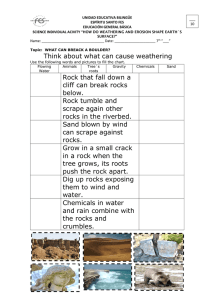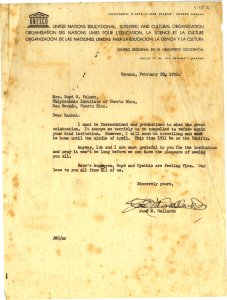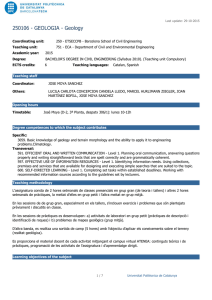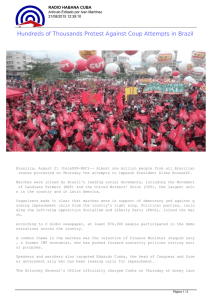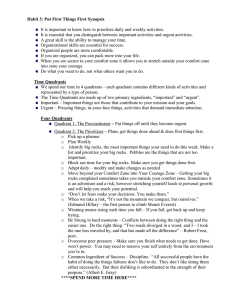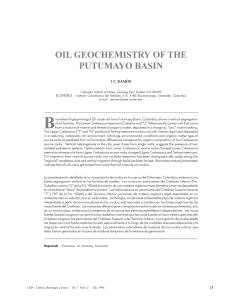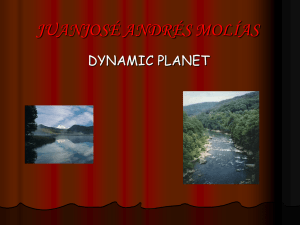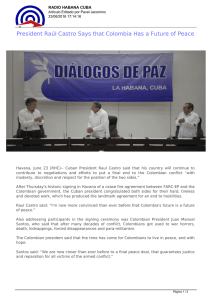Field Guide - Universidad de Granada
Anuncio
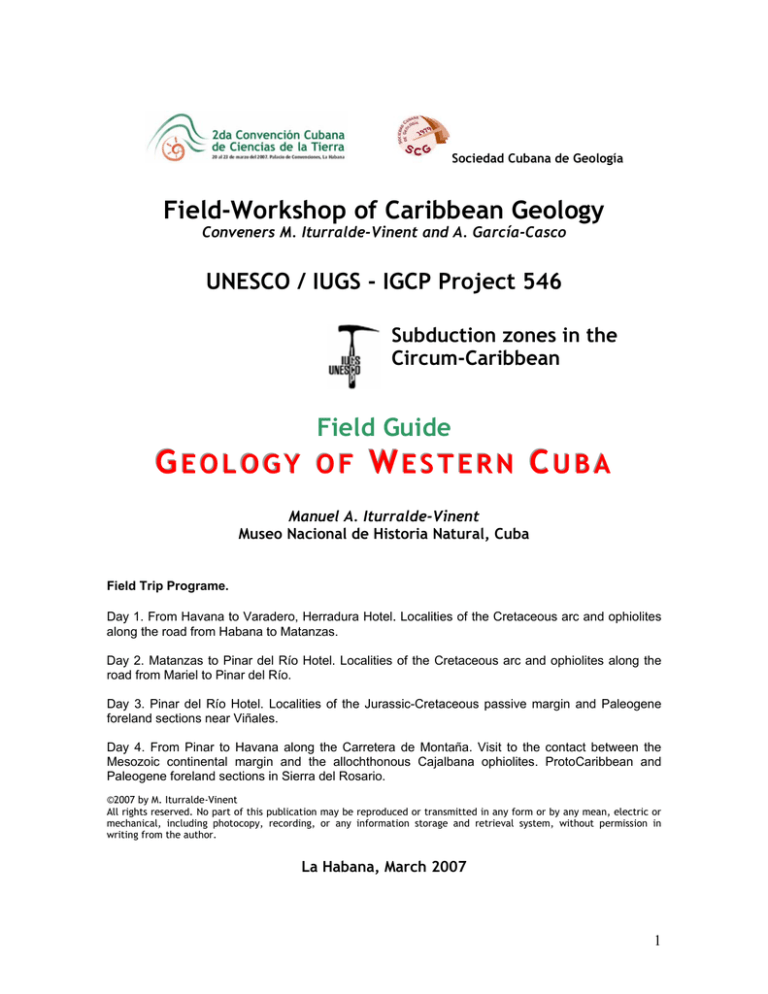
Sociedad Cubana de Geología Field-Workshop of Caribbean Geology Conveners M. Iturralde-Vinent and A. García-Casco UNESCO / IUGS - IGCP Project 546 Subduction zones in the Circum-Caribbean Field Guide GEOLOGY OF WESTERN CUBA Manuel A. Iturralde-Vinent Museo Nacional de Historia Natural, Cuba Field Trip Programe. Day 1. From Havana to Varadero, Herradura Hotel. Localities of the Cretaceous arc and ophiolites along the road from Habana to Matanzas. Day 2. Matanzas to Pinar del Río Hotel. Localities of the Cretaceous arc and ophiolites along the road from Mariel to Pinar del Río. Day 3. Pinar del Río Hotel. Localities of the Jurassic-Cretaceous passive margin and Paleogene foreland sections near Viñales. Day 4. From Pinar to Havana along the Carretera de Montaña. Visit to the contact between the Mesozoic continental margin and the allochthonous Cajalbana ophiolites. ProtoCaribbean and Paleogene foreland sections in Sierra del Rosario. ©2007 by M. Iturralde-Vinent All rights reserved. No part of this publication may be reproduced or transmitted in any form or by any mean, electric or mechanical, including photocopy, recording, or any information storage and retrieval system, without permission in writing from the author. La Habana, March 2007 1 INTRODUCTION Cuban Geologic Framework The geological framework and deep structure of the Cuban archipelago is by far the most complex among the Caribbean islands. Geologically speaking, the Cuban territory can be subdivided into two main geological entities (or structural levels): the pre Latest Eocene Foldbelt and the Neoautochthon. The Foldbelt encompass different suites of sedimentary, igneous and metamorphic rocks whose ages are as old as Neoproterozoic (1000 Ma), but usually of Early Jurassic to early Late Eocene. They outcrop mostly in mountain areas, but also in some dissected hilly and flattened terrains. These rocks were originated within the ProtoCaribbean sea and its continental margins off Bahamas and Yucatan; and within the Caribbean Plate and its volcanic islands. These tectonic units reached their present position as a consequence of tectonic transportation and amalgamation during Paleocene-early Upper Eocene. In the map are illustrated the main tectonic units which are part of the Cuban Foldbelt. The Neoautochthon represent less deformed sedimentary rocks of latest Eocene to Recent ages, which have not been significantly displaced from its original site of deposition. Study of the neoautochthon provides clues to the understanding of the evolution and consolidation of the present-day Cuban archipelago and shelf areas. This rocks are not coloured in the map. Schematic Tectonic Map of Cuba (Modified from Iturralde Vinent, 1998). Geology of Western Cuba Within the area of interest, the following tectonic elements can be distinguished from north to south: the Bahía Honda-La Habana allochthon which include ophiolites, Cretaceous arc volcanics, and sedimentary rocks of latest Cretaceous and Tertiary age; the Guaniguanico Terrane which includes Jurassic-Paleocene continental margin sequences and Paleogene foreland deposits; the Los Palacios Basin which contains Upper Cretaceous and Tertiary sedimentary rocks; the Guanal high which includes Miocene sedimentary rocks and a poorly known unexposed older section consisting of serpentinites and mafic igneous rocks; the La Coloma-Sabana Grande tectonic unit which contains Upper Cretaceous and Tertiary sedimentary rocks underlain by Cretaceous volcanic arc rocks; and the Pinos Terrane which includes Mesozoic metasiliciclastics and marbles of continental margin origin. Each one of these tectonic units exhibits a distinct stratigraphy and tectonic history (Iturralde-Vinent 1994, 1998). Bahía Honda-La Habana allochthon. With a few exceptions (e.g., Piotrowska, 1993), it is agreed that the Bahía Honda-La Habana thrust sheets were emplaced from the south-southeast on top of 2 the Guaniguanico Terrane (Hatten, 1957; Pszczolkowski, 1994). The exotic character of the Bahía Honda-La Habana belt is observed in the Martín Mesa window, northeast of Guaniguanico, where deformed Rosario belt rocks underlie in tectonic contact Bahía Honda-La Habana nappe. Modified from Kerr et al. (1999) The Bahía Honda-La Habana allochthon is represented by a lower, deformed ophiolite sheet (Cajálbana ophiolites), overlain by thrust sheets of Cretaceous calc-alkaline volcanics, pyroclastic and epiclastic deposits of ?Aptian to Campanian age. These units were deformed late in the Campanian at the time of the extinction of the volcanic arc (Pushcharovski et al., 1989). The volcanic arc section in the Bahía Honda-La Habana belt is unconformably overlain by upper Campanian and younger sedimentary rocks. Upper Campanian-Maastrichtian sedimentary rocks 3 consist of deep-water sandstone, claystone, and conglomerate of the Vía Blanca Fm. The clastic debris in these rocks is mostly derived from the erosion of an extinct volcanic arc. KTB deposits include calcareous megaturbidites (Peñalver Fm), which yield similarities to the Cacarajícara Fm of the Rosario belts (Tada et al., 2003). The Paleogene section has been divided into the Vibora Group (well-stratified conglomerate, sandstone, siltstone and claystone, usually with slumping and olistostromic intercalations), the Capdevila Fm (well-bedded sandstone, claystone and siltstone, with minor intercalations of conglomerate), the Universidad Fm (hemipelagic marl, radiolarian marl and marly limestone, with rare intercalations of fine clastics rocks toward the base); and the Punta Brava Fm (hemipelagic marl and marly limestone) (Pushcharovski et al., 1989). Clastic rocks of the Vibora Gp. and Capdevila Fms yield abundant debris derived from the erosion of the extinct volcanic arc. The upper Campanian-Eocene sedimentary basins that overlie the extinct arc in Cuba have been classified in general as "post-arc" or "superimposed to the arc" because they evolved in a new structural framework which developed after the extinction of the Cretaceous arc (Pushcharovski et al., 1989). Some of these basins, as in the Bahía Honda to Matanzas belt, evolved in a "piggyback" style during Paleocene-middle Eocene time (Iturralde-Vinent, 1994). Guaniguanico Terrane (Iturralde-Vinent 1994). The Early(?)-Middle Jurassic to early Paleocene stratigraphy of this unit has been described in detail by Pszczolkowski (1978, 1987, 1994, 2003). In general, the terrane have been subdivided into several belts with their own stratigraphic sequences, recording the evolution of Pangea into passive continental margin into a foreland basin. The belts have been named: Los Organos, Southern Rosario, Northern Rosario, QuiñonesGuajaibón and Felicidades. The generalized stratigraphic sections are shown in the stratigraphic columns. Maya Block borderland EARLY CRETACEOUS LATE CRETACEOUS LOS ORGANOS m cp st c Moreno Fm GUAJAIBÓN QUIÑONES FELICIDADES Moreno Fm Moreno Fm Quiñones Fm tr cm ab Pons Fm ne Carmita Fm Santa Teresa Fm ap th LATE JURASSIC Peñas Fm Proto-Caribbean basin ROSARIO NORTE ROSARIO SUR Carmita Fm Pinalilla Fm Santa Teresa Fm Santa Teresa Fm El Roble Mb Guajaibón Fm UNNAMED Encrucijada Fm Lucas Fm Polier Fm Tumbadero Mb Tumbitas Mb Americano Mb CHERTS AND SHALES LIMESTO NES AND SHALES LIMESTO NES Artemisa Fm km Artemisa Fm LIMESTO NES AND DO LO MITES San Vicente Mb. SANDSTO NES SANDST O NE, LUT IT ES AND SHALES BASALTIC RO CKS EARLY-MID JURASSIC ox REWO RKED VO LCANIC RO CKS Jagua Fm San Cayetano Fm. Francisco Fm El Sábalo Fm DEEP MARINE SHALLO W MARINE TERRESTRIAL San Cayetano Fm. Modified from Iturralde-Vinent (1996, 1998) 4 Characteristically the Guaniguanico unit shows a fold-thrust style of deformation, in which several thin-skinned thrust sheets were emplaced north- and north-westward, partially over autochthonous Mesozoic-Cenozoic Gulf of Mexico deposits. The pile of thrust sheets was later folded into an anticline whose hinge plunges north-eastward and is cut by the Pinar fault along its southern limb. Interpretation of the internal structure of the Guaniguanico unit shows that the thrust sheets of the Rosario area overlie those of Los Organos area Pszczolkowski (1978, 1987, 1994, 2003; Iturralde-Vinent, 1994, 1998). According to Iturralde-Vinent (1994) the original position of the belts within the Guaniguanico Terrane were reverse during thrusting, a conclusion based on the stratigraphy and facies relationships of the Paleogene sediments. Consequently, the original continental margin faced the Caribbean Sea before deformation. The stratigraphy of the Tertiary sections leading to this tectonic conclusion is illustrated in the following figure. Modified from Iturralde-Vinent (1996, 1998) Los Palacios Basin (Pushcharovski et al., 1989). In generalizations of the geology of Cuba, the unit is supposed to be underlain by Cretaceous volcanic arc rocks, but unequivocal volcanic arc rocks have not been recovered from the basin. Only the Güanal and Rojas wells, drilled in the Güanal structural high, recovered some fragments of serpentinite and mafic rocks below ~1000 m of Miocene carbonates. The older section know from this basin are Cenomanian-Turonian sandstone and siltstone with interbedded hemipelagic limestone, a section that resemble those of the Northern Rosario belts of Guaniguanico Terrane (Iturralde-Vinent, 1994). The Upper Cretaceous and Paleogene rocks of Los Palacios outcrop along a narrow belt parallel to the Pinar fault. The upper Campanian and Maastrichtian section consists of shallow water limestone interbedded with conglomerate composed of debris from Cretaceous igneous rocks (San Juán y Martínes Fm (Piotrowski, 1987). The exploratory wells drilled elsewhere in this tectonic unit penetrate upper Campanian-Maastrichtian arkosic sandstone which grades downwards into conglomerate and siltstone. The clastic component in these rocks is dominated by quartz and muscovite, but coarse-grained debris derived from a volcanic arc source is common near the base of the section (García et al., 1989). Planktonic and benthic foraminifera indicate an outer neritic environment (Fernández et al., 1988). The Paleogene section in Los Palacios is represented by the Vibora Group, and the Capdevila, Universidad and Loma Candela Fms (Piotrowski, 1987; García et al., 1989). These rocks are slightly to moderately deformed, with deformation intensifying near the Pinar fault. The clastic component is derived from the erosion of the Cretaceous volcanic arc. The lithology and age of Vibora Group and the Capdevila and Universidad Fms in this area are comparable with those in the Bahía Honda-La Habana and 5 Matanzas areas. Only the Late Middle Eocene Loma Candela and the Oligocene Guanajay Fms yield blocks derived from the Guaniguanico Terrane (Pszczolkowski, 1978; Albear et al., 1985). Geology of the Bahía Honda-La Habana and Matanzas The Bahía Honda-La Habana allochthon is represented by deformed ophiolites, ?Alptian to Campanian Cretaceous volcano-sedimentary rocks, covered by Latest Campanian and younger sedimentary rocks. This section may be folded and trusted repeatedly above the continental margin units (Albear et al. 1985). The Cajalbana ophiolites outcrop in northern Pinar del Río. This is a northward dipping rootless sheet, up to 1.5 km thick, which overlies the Guaniguanico Terrane. Associated with this contact occur an Early Eocene olisthostrome. On the north, the ophiolites are covered by a thrust sheet of Cretaceous volcano-sedimentary rocks. In general, the ?Aptian to Campanian arc-related section show similarities all along the Bahía Honda-La Habana area (Iturralde-Vinent, 1966). The lower ?Aptian-Cenomanian Encrucijada Fm are basalts with intercalations of volcanoclastics and carbonate rocks. In the Havana-Matanzas area this section is represented by the basalts and limestones of the Margot Fm and the well bedded vulcanoclastic Chirino Fms. The Turonian-Campanian section is dominated by marine pyroclastics of the La Trampa and Orozco Fms. Geochemically the Encrucijada and Margot Fms have been interpreted as a back arc trend (Zelepuguin et al., 1982; Kerr et al., 1999). These rocks are unconformably overlain by upper Campanian-Maastrichtian deep-water sandstone, claystone, and conglomerate of the Vía Blanca Fm. The clastics are mostly derived from the erosion of the extinct volcanic arc. KTB deposits in the area are represented by a calcareous megaturbidite (Peñalver Fm) as in La Habana-Matanzas area (Tada et al., 2003). SUR NORTE TECTONIC MAP (Pushcharovski et al., 1989), CROSS SECTION (Unpublished Oil Industry Report) 6 The lower Tertiary section was deposited in piggyback basins, partially during the tectonic emplacement of the Bahía Honda-La Habana allochthon above Guaniguanico. Therefore, the Tertiary section of the piggyback basins is less deformed than the section of the foreland basin. In some localities (such as near Las Terrazas), the deposits of the piggyback basins directly overlie Guaniguanico, but the contact is tectonic (Iturralde-Vinent, 1994). The lower Tertiary section has been divided into the Víbora Group (well-stratified conglomerates, sandstones, siltstones and claystones, usually with slumping and olistostromic-like intercalations), the Capdevila Fm (well-bedded sandstone, claystone and siltstone, with minor intercalations of conglomerate), and the Universidad Fm (hemipelagic marls, marly limestone, and radiolarian marls, with rare intercalations of fine clastic rocks toward de base). These clastic rocks were deposited during the thrusting of Bahía Honda onto Guaniguanico, so abundant slumping and thick conglomerates developed. The transition between the clastics and the marls (CapdevilaUniversidad) is coincidental with the end of the tectonic transport of Bahía Honda-La Habana units above Guaniguanico (Bralower and Iturralde-Vinent 1997). Late Tertiary deposits in the northern coastal area of Havana-Matanzas dip gently toward the north. Miocene rocks are divided into the marly Cojimar Fm and the carbonate Güines Fm which outcrop from Habana to Matanzas. Late Miocene-Pliocene deposits are only locally developed at the Morro Castle of La Habana (the Morro limestones) and near Matanzas city at El Abra de Yumurí (El Abra Fm). Pleistocene rocks include carbonate shelf and coastal deposits, subdivided into several formations and uplifted into as many as four marine terraces. Several levels of eolian sediments are quite well exposed (Albear et al., 1985). DESCRIPTION OF THE STOPS DAY 1. Havana-Matanzas serpentinites and Cretaceous Volcanic Arc In several locations along the road from Habana to Matanzas crops out serpentinitic rocks. Gabroids, basalt and boninites asscociated to the serpentinites are also present, but far from the road in locations not to be visited during this field trip (See Albear et al., 1985; Kerr et al., 1999). Stop at Bacunayagua Fm Exposures of brecciated serpentinitic rocks resting on top of Latest Cretaceous arcose of the Bacunayagua Fm. In this locality the serpentinites are thrust above the younger Bacunayagua arcose. The Bacunayagua Fm (Albear et al. 1985) contains fragments of oldest metamorphic rocks and minerals within a quartz-rich matrix. In the petroleum wells, where it has been dubbed ¨Capa A¨ it is found strongly associated with the Via Blanca Fm. Its age is yet to be properly addressed, but may be Maastrichtian or Paleocene. Stop at Canasí Exposures of vulcanoclatic rocks of the Late Cretaceous Chirino Fm. These are greenish and brown coloured fine grained well bedded andesitic tuffs and sandstones, locally thick bedded, with intercalations of grey laminated limestones, radiolarian cherts, and few andesites bodied. The Chirino Fm is very common in the Havana-Matanzas area, where vulcanoclastic deposits dominate the Late Cretaceous sections. Stop at Concuní Section located SW of Canasí along the road to Jibacóa. Exposures of the siliciclastic flysch of the latest Campanian-Maastrichtian Vía Blanca Fm. The unit present excellent examples of submarine water flow structures at the base of the sandy beds. At the sole you may also found 7 ichnofossilsl. Very interesting in this outcrop is the presence of synsedimentary slumping involving whole pieces of the formation. Isolated blocks of strongly weathered plutonic rocks may be also found intercalated in the uppermost part of the section (Albear et al. 1985), crowened by a large block of the same lithology. Above Vía Blanca here occur well bedded limestones and shales of the Paleocene Via Crucis Fm. DAY 2. Bahía Honda Ophiolites and Cretaceous Volcanics BH1. Stop of the Ophiolites. These outcrops belong to the same Cajalbana belt where the serpentinite melange contain blocks of Early Cretaceous high-P metamorphic rocks as in the serpentinitic olistoplates found within the Manacas Fm in the Rosario Belt (García-Casco et al., 2005). BH2. Stop of the Orozco Fm The Cenomanian and younger Orozco Fm is a volcano-sedimentary section of well bedded light green to white tuffites with some intercalations of basaltic and andesitic porphyry sills and flows. Eventually some few meters thick intercalations of conglomerates of basaltic boulder are found. The tuffaceous rocks crops out in the sea shore at Playa Punta de Piedra. BH3. Stop of the Encrucijada Fm Outcrop on the road heading South to Cacarajícara, West of Bahía Honda, 1 km south of the intersection with the road to La Mulata, Pinar del Río Province. Also in the river Las Pozas, 200 m northwest of the first bridge on the road heading south to Cacarajícara, and along the road west of the intersection to Cacarajícara. The section are fine to medium grained basalts, with altered plagioclase and olivine, intercalated with well bedded hemipelagic limestones and cherts. The ?Aptian-Cenomanian Encrucijada Formation (Zelepuguin et al, 1982) may represent fragments of the proto-Caribbean oceanic basin (Kerr et al., 1999). DAY 3. Sierra de los Órganos From Viñales town, toward Valle de San Vicente, stop at the intersection with the road to Laguna de Piedra. On the slopes of Abra del Ancón were found the first Jurassic fossils reported from Cuba, late in the XIX century, by Manuel Fernández de Castro and shortly after by Carlos de la Torre y Huerta. Stop 1. Exposures of San Cayetano Fm and Jagua Fm near Mogote La Mina This stop is reached by driving along the road to Laguna de Piedra from Viñales, and turning to the east, at the first intersection after the entrance to República de Chile. Drive 1.5 km. The San Cayetano Formation is the oldest stratigraphic unit known in Guaniguanico mountains. It represents a siliciclastic shelf and coastal plain environment, with sedimentary features typical for these facies. Terrestrial deposits occur in Sierra de los Organos with dry-land and brackishwater coastal plains. Shallow marine incursions are also found as intercalations that yield bivalves. The age of the unit is identified as Lower? To Upper Jurassic (early Oxfordian) (Pszczolkowski, 1978, 1994). The San Cayetano Fm represents synrift sedimentation coeval with the break-up of Pangea. It is locally cut by dikes and sills of basic igneous rocks. Some of the sedimentary facies of San Cayetano, consist of well-bedded reddish and yellowish fine- to medium-grained sandstones with shales. The sandstones yield muscovite derived from Arkean, Grenville and Pan African terranes. In western Cuba Jurassic evaporites are not present. Above San Cayetano is developed the Jagua Formation, subdivided in several members. The Jagua Vieja Member is represented by dark shales and thin-bedded limestone, with embedded highly fossiliferous laminated calcareous concretions. The only Jurassic vertebrates known from the Caribbean have been recovered from these concretions, and yield fossil fishes, turtles, 8 plesiosaurs, pliosaurs, metriorhynchus crocodiles, pterosaurs and ammonites. The Jagua Fm is covered by the San Vicente member of the Guasasa Formation. Stop 2. Walls of Valle de San Vicente: Jagua and Guasasa Fms. This section is reached by driving south-westward from Viñales Town in the direction of Motel Rancho San Vicente. Just at the intersection to Laguna de Piedra, looking northward, begins the Abra del Ancón. At the gentle slope of the “mogote” hill on both sides of El Abra is found the Oxfordian Jagua Fm, represented by well-bedded shales with laminated fossiliferous limestone concretions (Jagua Vieja member), followed by well-bedded limestones (Pimienta member) exposed on the walls of the mogotes (Pszczolkowski, 1978). At the top of the well-bedded limestones is located the base of the Guasasa Formation The base of Guasasa Fm is a limestone breccias that can be observed on the wall just left of the Cueva de Viñales bar. Some geologists in the past saw in this breccia a tectonic unit, but most probably it is a sedimentary bed deposited during the onlap event. Above the breccia, the massive limestones of the San Vicente Member (Guasasa Fm) are found. These limestones are latest Oxfordian to earliest Tithonian in age, and represent a carbonate platform known only in the Los Organos mountains area of western Cuba. The limestones are massive to thick-bedded, grey to black, totally or partially dolomitized. Micritic limestones dominate the lower section, whereas calcarenites are more common upward (Pszczolkowski, 1978). Stop 2A.Spot near Cueva del Indio. J-K Boundary. The San Vicente carbonate bank evolved upward into more open marine carbonates and cherts of the El Americano, Tumbadero and Tumbitas members, representing drowning and extinction of the carbonate platform. They are well stratified limestones with calpionellids, radiolaria and other nannofossils, occasionally ammonites (Pszczolkowski, 1978). The Jurassic-Cretaceous boundary here is almost coincident with the El Americano-Tumbadero contact, which shows a minor unconformity. El Americano Member: Is the lower part of the section above the San Vicente thick bedded limestones, represented by well-bedded, dark-grey to black limestones with some dolomites, up to 45 m thick. J/K boundary: Minor unconformity between El Americano and Tumbadero. Tumbadero Member: Thin-bedded to laminated limestones with black chert intercalations, that reaches 20 to 50 m thick. Tumbitas Member: Thick-bedded, compact, lightgrey micritic limestones with some thin Intercalations of darker limestones, ranging from 40 to 50 m thick. Stop 5. In the Viñales-Pons road at the Moncada intersection. Outcrop of the Late Cretaceous Pons Fm, the KTB Moncada Fm, the Paleocene Ancón Fm, and the late Paleocene to Lower Eocene Manacas Fm. These units are deformed and Ancon displays a faint foliation. They are at the top of the Los Órganos belt, underlying a major thrust surface. DAY 4. Rosario and Bahía Honda From Viñales to La Palma drive up to the intersection located 2 km SE of La Palma, turn east toward Mil Cumbres and Niceto Pérez, the so-called Carretera de Montaña. Stop 6. Exotic serpentinite blocks in Paleocene-Eocene Manacas Fm Exposures of Manacas Fm from 2.5 to 8.2 km. These outcrops yield large exotic blocks of serpentinites and other ophiolites Following the road: • Exposures of Manacas Fm from 9.7 to 11.5 km. Stop 7. Allochthonous thrust sheet of ophiolites. After 12 km, the contact between Guaniguanico terrane and Bahía Honda-La Habana allochthon is visible. This is a large thrust fault that superimposed the Cajálvana ophiolites and Bahía Honda 9 volcanic arc rocks above the Guaniguanico terrane. Following outcrops of serpentinites and laterites from 14 to 20 km. Stop 8. KTB Cacarajicara Fm and view of the Guajaibón Aptian-Cenomanian platform At 24 km near Mameyal, scenic view of the Pan de Guajaibón, looking north. The Guajaibón Fm is an Albian to Cenomanian carbonate bank, which is part of a section located north in Sierra del Rosario. This bank is interpreted in different manners, as an old knoll within the western Caribbean offshore Yucatan, or as a fragment of the Yucatan platform (IturraldeVinent, 1998). • • • • • Albian Santa Teresa cherts thrust onto lower Eocene Vieja olistostrome from 32 to 33 km, 4 km before Niceto Pérez Niceto Pérez. Turn in the intersection to the left; it is the road to Soroa and Las Terraza Scenic view looking north 7.4 km from Niceto Pérez. The coastal plain north of the mountains is the Bahía Honda tectonic unit. San Cayetano-Artemisa Fms contact 8.7 km after Niceto Pérez Artemisa Fm from 9.4 to 10 km after Niceto Pérez BH1 BH2 BH3 TECTONIC MAP OF WESTERN CUBA (Pushcharovski et al., 1989) Stop 9. Cretaceous deep-water deposits in the Rosario mountains, Exposure on the left side of the road, 10.3 km after Niceto Pérez. Four units are present in this exposure: the Polier Fm limestones and shales, the Roble sandstone member of the Polier, the Santa Teresa cherts and the Carmita limestones and cherts. They represent the Lower Cretaceous Hauterivian? to Turonian? basinal marine section, probably facing the Caribbean sea (IturraldeVinent, 1994). Within the Poliere Fm are found veins of calcite impregnated of dry oil and veins with same impregnations. A similar pattern of Cretaceous facies development is found as the Placetas Belt in Central Cuba, at the southern slope of the Bahamas platform (exposed in northcentral Cuba). In contrast to the isochronous section in Sierra de los Organos, the Rosario Belt yields clastic sediments from a deeper water environment. 10 The outcrop is deformed, but still the units preserve the original superposition. From oldest to youngest are: The Polier Fm is composed of thin-bedded, grey, micritic limestones intercalated with sandstones and shales. The sandstones are yellow-brown, fine- to medium-grained, with some calcareous cement. They display flute casts, groove casts, cross and horizontal lamination and graded bedding. The clastic component is dominated by quartz with plagioclase and muscovite. The Roble member (of the Polier Fm) is composed of thick-bedded, medium-grained quartz sandstones, with few clayey shale intercalations. They display graded bedding, and abundant sole casts. The Santa Teresa Fm is composed of well-bedded turbidite silicified sandstones, red to greenish-brown ribbon cherts and a few green shale intercalations. Sedimentary features typical of deep-water deposition are visible. The cherts are usually strongly folded. The Carmita Fm is light grey, well-bedded micritic limestone with interbedded radiolarian cherts and shales (Pszczolkowski, 1978, 1999). • Exposures of San Cayetano Fm near 7.8 km Stop10. Exposures of Artemisa Formation These limestones are exposed 13.5 to 14.5 km from Niceto Pérez, 2.5 km before the intersection with the road to Soroa. Section of Late Jurassic (late Oxfordian) to Early Cretaceous well-bedded micritic, dark grey to black limestones and some black calcareous shales, with a few intercalations of coarse grained calcarenites. Sometimes aptychi are found in the limestones. The calcarenites in the lower (Kimmeridgian) part of the section are probably derived from the coeval carbonate platform in Los Organos (San Vicente mb of Guasasa Fm). Bioclastic limestones and coquinas composed of ammonite shells and aptychi are found near the top, as are some biomicritic limestones with radiolaria, calpionellids and other microfossils. In the late Tithonian, as elsewhere in Cuba, the first intercalations of cherts are found suggesting a general deepening of the sea floor (Pszczolkowski, 1978). • After this stop is exposed the San Cayetano Fm up to the intersection with the road to Bahía Honda. Drive across it and follow the road to Las Terrazas. Stop 11. The Early to Late (early Oxfordian) Jurassic San Cayetano Fm in Rosario mountains The formation crops out from 800 m to 1.5 km after the intersection with the Road to Bahía Honda. Exposures of the San Cayetano Fm in Sierra del Rosario are interpreted as been more dominated by marine facies than their isochroous in Los Organos (Pszczolkowski 1978, 1999). This outcrop has thin-bedded to slaty shales with bitumen, and thin to coarse-grained sandstones to conglomerates, often with small fragments of plant remains. The rocks are quartz and mic rich. • • Manacas Fm 4.5 km after the intersection. Exposures of Late Cretaceous units from 5 to 7.5 km Stop 12. Oxfordian-early Kimmeridgian El Sábalo basalts These exposures are found 7.5 to 10.5 km after the intersection with the road to Bahía Honda. The El Sábalo Fm (Pszczolkowski, 1978) is a thick volcano-sedimentary unit deposited at the continental margin, during extension (and thinning) of the sialic crust. Because this continental margin was probably facing the Caribbean sea, the thick basaltic extrusives suggest an active event of ocean spreading (drifting) in the basin (Iturralde-Vinent, 1994). The El Sábalo underlies the Artemisa Fm in this area as can be observed in several places where the limestone cap the elevations built up by basalts. The El Sábalo is composed of massive or pillow basalts and hialoclastites with thin intercalations of laminated limestones and shales. These intercalations contain microfossils (Globochaete alpina, Colomisphaera spp. and spicules of Didemnidae) (Pszczolkowski, 1994). These basalts are geochemically different to those found within the ophiolitic and volcanic arcs of Cuba (Iturralde-Vinent, 1989). 11 SOME REFERENCES AND SOURCES OF INFORMATION American Association of Petroleum Geologists, 2003. Memoire 79, CD-ROM and book. Albear, J. F., et al. 1985. Contribución a la geología de las provincias de La Habana y Ciudad de La Habana . Editorial Científico-Técnica, La Habana. Bronnimann, P. and Rigassi, D., 1963. Contribution to the geology and paleontology of the area of the city of La Habana, Cuba, and its surroundings. Eclog. Geol. Helvetiae 56 (1): 193-480. Fonseca, E., M. Zelepuguin y M. Heredia, 1984. Particularidades de la estructura de la asociación ofiolítica en Cuba: Revista Ciencias de la Tierra y del Espacio (9): 31-46. García-Casco, A., Torres-Roldán R. L., Iturralde-Vinent, M. A., Millán, G., Núñez Cambra, K., Lázaro, C. & Rodríguez Vega, A. 2006. High pressure metamorphism of ophiolites in Cuba. Geologica Acta 4, 63-88. Iturralde-Vinent, M. 1994, Cuban Geology: A new plate tectonic synthesis: Journal of Petroleum Geology, v. 17, p. 39-70. Iturralde-Vinent, M. (Ed.) 1996: Cuban ophiolites and volcanic arcs: IGCP Project 364, Special Contribution no. 1: i-265 ; Miami, Florida Iturralde-Vinent, M.A., Lidiak, E.G., Editors, 2006. Caribbean Plate Tectonics. Stratigraphic, Magmatic, Metamorphic and Tectonic Events (UNESCO/IUGS IGCP Project 433). Geologica Acta. vol. 4, no. 1-2, 341 p. Kerr, A.C, Iturralde-Vinent, M.A., Saunders, A.D.; Babbs, Tanya L. and Tarney, J. 1999. A new plate tectonic model of the Caribbean: Implications from a geochemical reconnaissance of Cuban Mesozoic volcanic rocks. Geological Society of America Bulletin, 111 (11): 1581-1599. Pszczolkowski, A., 1999. The exposed passive margin of North America in western Cuba. In P. Mann (Ed.) Caribbean Basins, (Series ed. K.J.Hsü) Sedimentary basins of the World 4. Elsvier Science B.V. Amsterdan. p. 93-121. Pushcharovsky, Yu.,A. Mossakovsky, G. Nekrasov, S. Sokolov, M. Iturralde-Vinent et al. 1989. Tectonics of the Republic of Cuba. Explanatory note to the tectonic map of Cuba scale 1:500 000 : Ed. Nauka, Moscow, 77 p. Rigassi-Studer, D. 1963. Sur la geologie de la Sierra de los Organos: Arch. Sci. Soc. Phys. et Hist. Nat. (Geneva) 16(2), 339-350. Zelepuguin, V., Fonseca, E., and Díaz de Villalvilla, L. 1982, Asociaciones vulcanógenas de la provincia de Pinar del Río: Serie Geológica, Centro de Investigaciones Geológicas, Cuba, v. 6, p. 42-74. WEB SITES Caribbean Geology and Plate Tectonics www.utig.utexas.edu/CaribPlate/CaribPlate.html Origin of the Caribbean and its marine and terrestrial biota www.redciencia.cu/cdorigen/arca/index.htm Basic Lectures in Geology of Cuba www.medioambiente.cu/uptnatgeo/index1.htm Cuban Geological Society www.scg.cu 12
